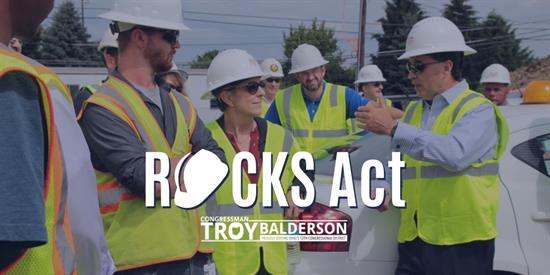WASHINGTON – Congressmen Troy Balderson (R-OH) and Greg Stanton (D-AZ) have reintroduced their bipartisan legislation that would promote the use of local aggregate resources such as stone, sand, and gravel in construction projects to reduce costs and bolster local producers. The lawmakers previously introduced the Rebuilding Our Communities by Keeping Aggregates Sustainable (ROCKS) Act in the 116th Congress.
“Ohio’s land is rich with the raw materials used in building and construction projects,” said Balderson. “Encouraging the use of these aggregates like sand and stone in local projects benefits both sides: the buyer is able to more efficiently obtain the materials through reduced transportation time and costs, and the supplier’s business growth benefits the local economy and jobs market.”
“Arizona is a state that has had to be smart about managing its aggregates resources,” said Stanton. “To build the infrastructure we need to support our growing population, we have to consider where our building materials come from and how we move them to construction sites. Arizona has been a leader in innovative policies to address this challenge—and now we’re taking those lessons to the federal level.”
The ROCKS Act would require the U.S. Secretary of Transportation to establish a working group of federal, state, and local stakeholders to examine the use of aggregates and develop a federal framework to ensure continued access to this critical resource.
“In Ohio, it is estimated that each resident needs over 10 tons (20,000 pounds) of locally available aggregate resources each year,” said Patrick Jacomet, Executive Director of Ohio Aggregates and Industrial Minerals Association. “These aggregate resources are used in homes, schools and medical facilities and are critical to the maintenance of our transportation, water, sewer and utilities infrastructure. Ultimately, continued access to these vital resources is imperative and the ROCKS Act is an important first step in developing a strategy to ensure this access. We urge the support of this Act by all Ohio elected officials and look forward to working with our congressional delegates in seeking the passage of the ROCKS Act. We especially want to thank Congressman Troy Balderson and Congressman Greg Stanton for their leadership and vision.”
“The 400 members of the National Stone, Sand & Gravel Association applaud Rep. Greg Stanton and Rep. Troy Balderson for introducing the ROCKS Act,” said Michele Stanley, NSSGA Vice President of Government and Regulatory Affairs. “Their leadership to advance this bipartisan legislation, that promotes sustainable access to needed construction materials, will improve the lives of all Americans. Aggregates are the second most utilized product in the world and are the bedrock in the creation of buildings, roads, airports and bridges. They are indispensable in developing the infrastructure needed to access to clean water, deliver reliable energy and advance environmental stewardship. It is imperative that all communities have access to these essential resources as we work together to improve our outdated infrastructure. Sustainable, local access to aggregate materials improves construction costs, extends taxpayer dollars, reduces congestion and leads to better environmental outcomes.”
BACKGROUND
Stone, sand, and gravel are essential raw materials found in every home, building, road, bridge, and public works project. Every year, the United States extracts more than 22,000 pounds of aggregates per person.
Eliminating or constraining local access to aggregates has a variety of unintended consequences, including increased construction costs and negative environmental impacts.
Under the ROCKS Act, the established working group will:
- Study the use of aggregates resources in federally funded transportation and construction projects and how the proximity of aggregates resources impacts cost and the environments;
- Examine how state and local transportation and planning agencies may consider aggregates resources when developing projects;
- Identify measures the federal government, state, and local transportation and planning agencies may take to preserve currently identified aggregates resources for future development.
|
###


